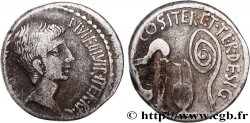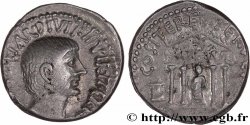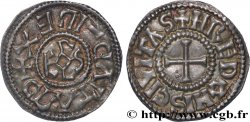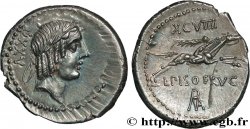v50_0001 - OTTAVIANO Quinaire
MONNAIES 50 (2011)
Prezzo di inizio : 320.00 €
Valutazione : 550.00 €
Prezzo realizzato : 405.00 €
Numero di offerte : 5
Offerta maxima : 503.00 €
Prezzo di inizio : 320.00 €
Valutazione : 550.00 €
Prezzo realizzato : 405.00 €
Numero di offerte : 5
Offerta maxima : 503.00 €
Tipo : Quinaire
Data: 29 AC.
Nome della officina / città: Asie, Éphèse
Metallo : argento
Titolo in millesimi : 950 ‰
Diametro : 14 mm
Asse di coniazione : 11 h.
Peso : 1,92 g.
Grado di rarità : R1
Commenti sullo stato di conservazione:
Exemplaire sur un petit flan bien centré au droit, légèrement décentré au revers avec les grènetis visibles. Très beau portrait d’Octave au droit, bien venu à la frappe, de style fin. Joli revers de haut relief avec une petit faiblesse de frappe sur la Victoire. Très belle patine de médaillier avec des reflets mordorés
N° nelle opere di riferimento :
C.14 (4f.) - RIC.276 - BMC/RE.647 - BN/R.901 - RCV.1568 (400$) - BMC/RR.240 (East) - CRI.429 - RSC.14 - MRK.2 /5
Pedigree :
Cet exemplaire provient de la collection du Docteur Nicolas, 9 et 10 mars 1982, n° 72
Diritto
Titolatura diritto : CAESAR - IMP VII.
Descrittivo diritto : Tête nue d’Octave à droite (O°).
Traduzione diritto : “Cæsar Imperator Septimum”, (César revêtu de la septième acclamation impériale).
Rovescio
Titolatura rovescio : ASIA - RECEPTA.
Descrittivo rovescio : Victoria (la Victoire) debout à gauche, tenant une couronne de la main droite et une palme de la gauche, sur la ciste mystique, de laquelle sort de chaque côté un serpent.
Traduzione rovescio : “Asia Recepta”, (L’Asie conquise).
Commento
L’attribution de ce quinaire est controversée. C. H. V. Sutherland (RIC. 276) le donne à l’atelier de Rome ou de Brindisium frappé entre 29 et 27 avant J.-C. alors que J.-B. Giard le donne à l’atelier d’Éphèse (BN/R., p. 44, pl. XXXV, n° 899) en août 29 avant J.-C. Le style fait néanmoins penser à un atelier oriental.
The attribution of this quinary is controversial. CHV Sutherland (RIC. 276) gives it to the mint of Rome or Brindisium struck between 29 and 27 BC while J.-B. Giard gives it to the mint of Ephesus (BN/R., p. 44, pl. XXXV, n° 899) in August 29 BC. The style nevertheless suggests an oriental mint
The attribution of this quinary is controversial. CHV Sutherland (RIC. 276) gives it to the mint of Rome or Brindisium struck between 29 and 27 BC while J.-B. Giard gives it to the mint of Ephesus (BN/R., p. 44, pl. XXXV, n° 899) in August 29 BC. The style nevertheless suggests an oriental mint








 Segnalare un errore
Segnalare un errore Stampate la pagina
Stampate la pagina Condividi mia selezione
Condividi mia selezione Fai una domanda
Fai una domanda Consegnare / vendere
Consegnare / vendere
 Descrittivo
Descrittivo















